 Thanks: 0
Thanks: 0
 Needs Pictures: 0
Needs Pictures: 0
 Picture(s) thanks: 0
Picture(s) thanks: 0
Results 1 to 15 of 25
Thread: Marking mortices (Part II)
-
4th November 2013, 01:24 AM #1
 Marking mortices (Part II)
Marking mortices (Part II)
The other day I received an email inviting me to purchase the latest one-time tool from Woodpeckers, a mortice and tenon centre gauge ..

Here is the link to their website for those interested: OneTime Tool - MT Center Gauge PWW1
My first thought was that this was brilliant - what a great, quick way to mark a mortice (or tenon) in the centre of a stretcher. Then I looked at the price ($150), and that one had to pre-order now for 5 months time. I put away the credit card.
I still think that it is a terrific idea, and I must admit that the concept haunted me for some days. Today - Sunday - I decided to build my own version. So I looked around the workshop for something to cannibalise.
I found an old dovetail marker that had never worked and had been tossed into a drawer ...
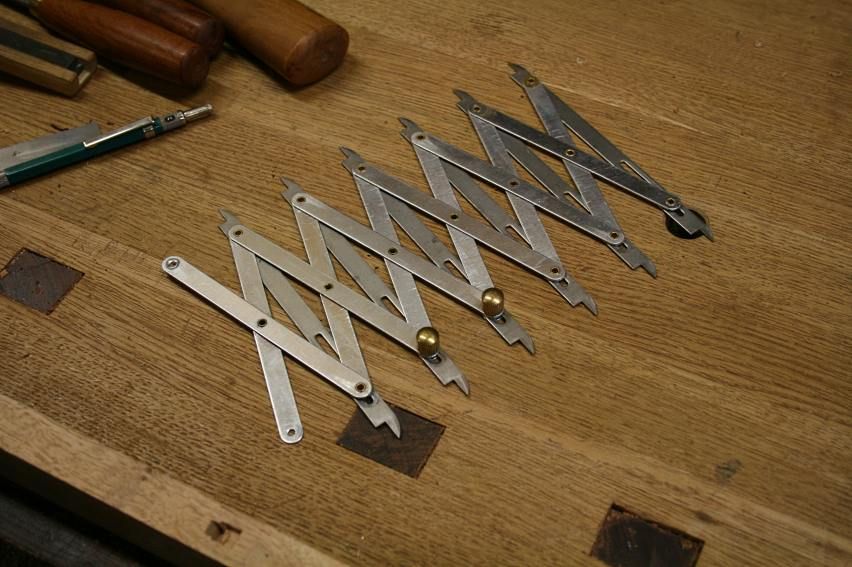
This is the centre gauge I built ...
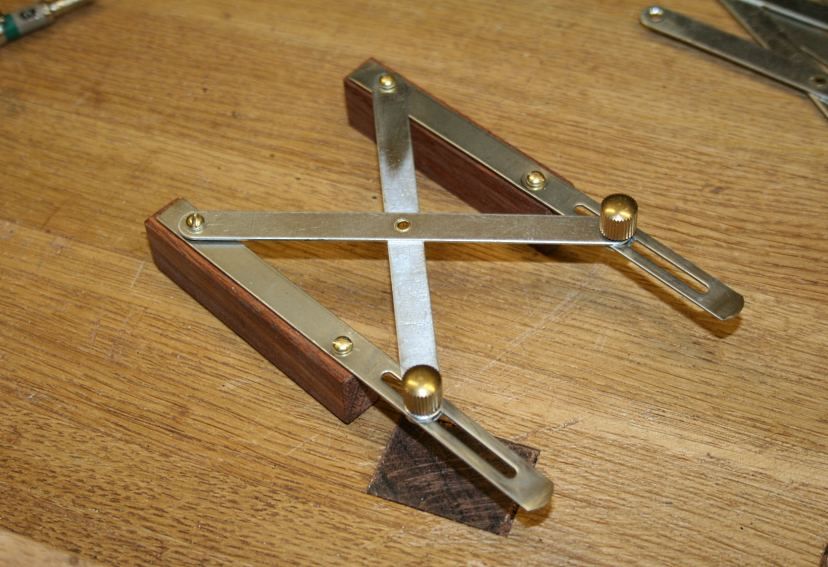
It slips over the stretcher this way ...

Marking out for a 3/4" wide stretcher calls for a 1/4" wide mortice. This one will be 2" long.
Step #1 is to mark off the 2" length (with room to avoid blowing out the end) ...

Now place the centre gauge between the two end lines (anywhere, it is not critical). Set the 1/4" mortice chisel against the centre, eyeballing it square ...
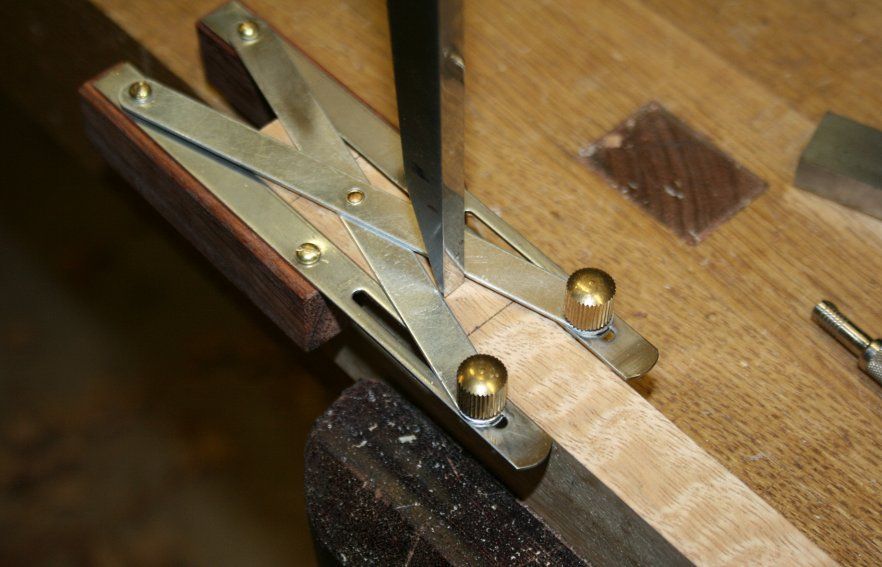
Press done hard so that you leave a clear imprint of the chisel ...
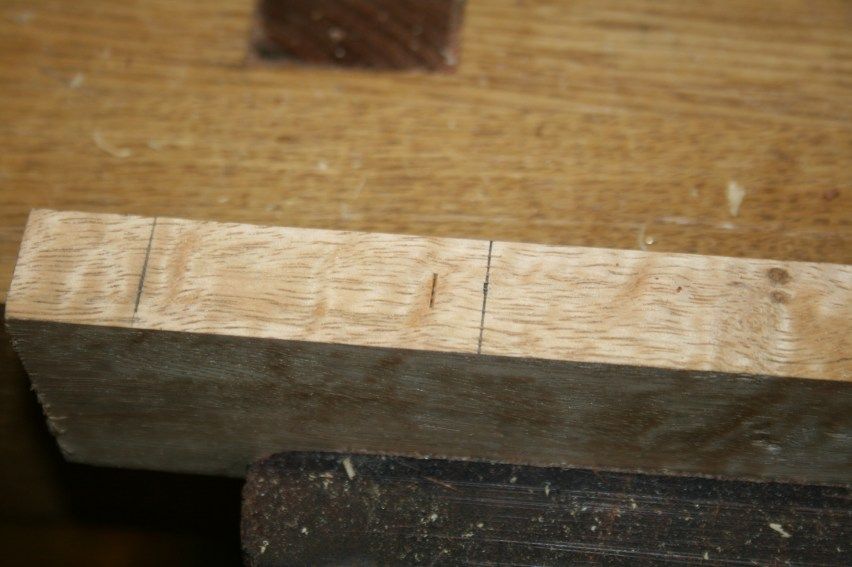
Now you have a choice - either use two single blade cutting gauges to mark each line individually (you will need to set these aside for the tenon) ...
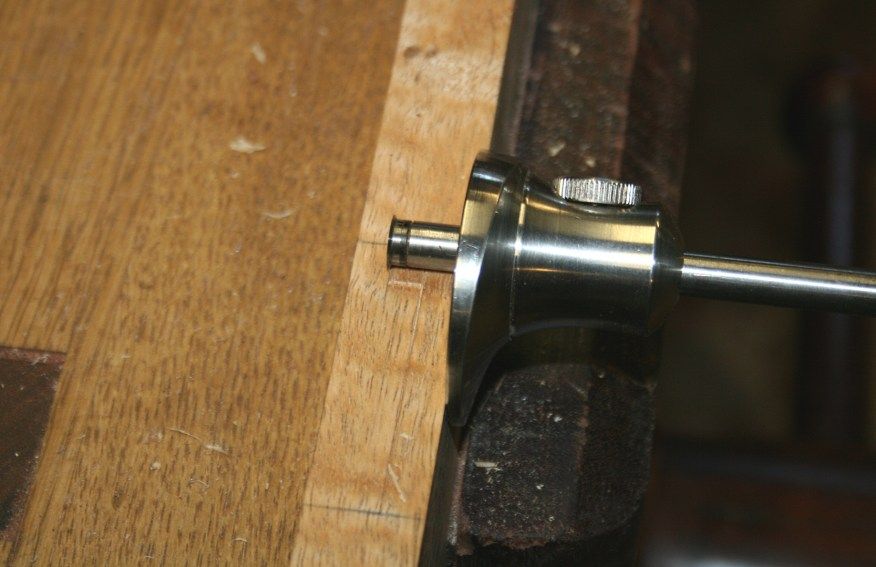
... or use a mortice gauge, aligning the blades with the outer edge of the imprint ...
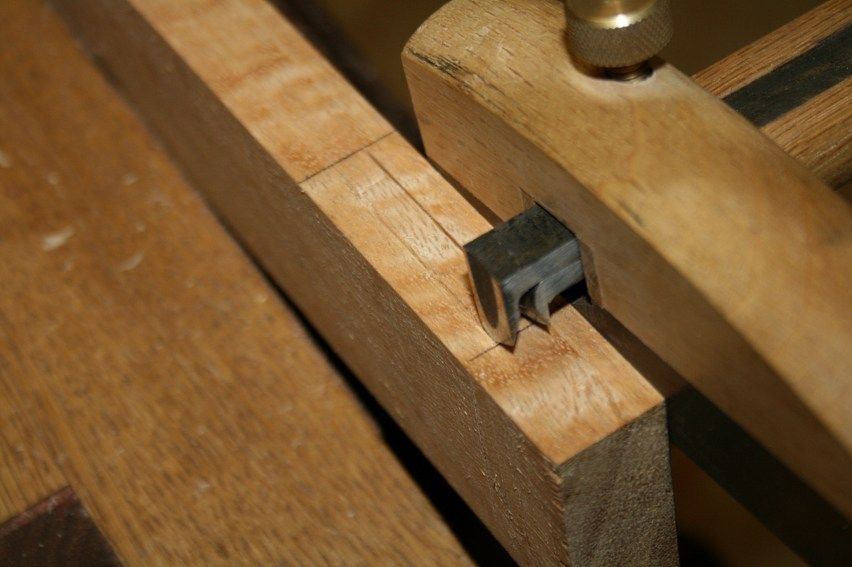
It has never been critical to centre the mortice, but this method does speed up the process (even though this is all a bit tongue-in-the-cheek). Is it accurately centred? I did three or four. None were perfectly centred. Some error creeps in. It does not matter. As long as you use the same gauge(s) and score from the reference side, each mortice/tenon will be marked at the same distance from the sides.
Regards from Perth
DerekVisit www.inthewoodshop.com for tutorials on constructing handtools, handtool reviews, and my trials and tribulations with furniture builds.
-
4th November 2013 01:24 AM # ADSGoogle Adsense Advertisement
- Join Date
- Always
- Location
- Advertising world
- Posts
- Many
-
4th November 2013, 09:09 AM #2

Derek, that was an interesting challenge and an imaginative solution. As you say, accuracy is more important than precision, in this context, & easily achieved by consistent setting-out. Always marking out from the face sides & 'good' edges was something drilled into us in my 7th grade woodworking class. In fact, I quite often deliberately don't centre mortises. On thin doors with narrow stiles & rails, for example, I may place the mortises so that the panel groove doesn't remove a significant chunk of the tenons.
I'm sure you know this, but there is a very simple & accurate method for quickly finding the centre of a board. Take an ordinary pin gauge, set it by eye to what you think is the middle, and make a small 'dot' from either side. It doesn't matter if you set slightly over, or under, they will be pretty close, then reset the pin between these marks, which will be dead centre of the board. If you want to double-check, the gauge should score in exactly the same place from either side of the board (as long as your board preparation was accurate!). I probably use this several times a day - takes less than 5 seconds and is as accurate as your eye can detect.....
Cheers,IW
-
4th November 2013, 10:17 AM #3

Hi Ian
Somehow we all have managed to get by without a marking tool such as this. It is a useful but unnecessary tool.
What do they say about "idle hands". I am waiting on the delivery of a chair that I plan to measure before I build a version of it. I've cut the wood, cleaned the shop ... can you tell I'm a little restless ?
Regards from Perth
DerekVisit www.inthewoodshop.com for tutorials on constructing handtools, handtool reviews, and my trials and tribulations with furniture builds.
-
4th November 2013, 07:23 PM #4
 SENIOR MEMBER
SENIOR MEMBER











- Join Date
- Oct 2009
- Location
- South Africa
- Posts
- 950
-
4th November 2013, 08:37 PM #5
 Hi IanAlways marking out from the face sides & 'good' edges was something drilled into us in my 7th grade woodworking class. In fact, I quite often deliberately don't centre mortises. On thin doors with narrow stiles & rails, for example, I may place the mortises so that the panel groove doesn't remove a significant chunk of the tenons.
Hi IanAlways marking out from the face sides & 'good' edges was something drilled into us in my 7th grade woodworking class. In fact, I quite often deliberately don't centre mortises. On thin doors with narrow stiles & rails, for example, I may place the mortises so that the panel groove doesn't remove a significant chunk of the tenons.
I think that I said the same things. This was an exercise in marking without measuring. The result is the same.
The thing is we often do aim for a centred mortice, or as centred as we can get it. Think of all the frame-and-panels you have made. This tool would not be used for offset or double mortice-and-tenon arrangements, such as in doors. It is actually a pretty useful tool. Its downside is that it is another tool, and all of the time we do not actually need it. It is not a solution for a problem-that-doesn't-exist, but it is an aid for those who want to mark out mortice-and-tenons for specific situations. Now that I have made it I shall use it. If I did not have it I would not miss it.
Regards from Perth
DerekVisit www.inthewoodshop.com for tutorials on constructing handtools, handtool reviews, and my trials and tribulations with furniture builds.
-
4th November 2013, 09:50 PM #6

I too receive invitations to buy the Woodpeckers One time tools from three different sources that market Woodpeckers products. I have even bought a few of them.
Most of them, like the current offering posted by Derek, really do not have anything to offer the (for want of a better word) more "innovative" woodworkers.
For example, there is no way I would have bought their Pythagoras gauge or the Fibonacci gauge. I had my own long before they released theirs.
Would I be tempted by a CNC cut accurate straightedge or a guaranteed accurate right angle. Well if the price is right, yes I have.
It must be hard for the designers at Woodpeckers to keep coming up with a new one-time-tool every month or whatever interval they release them. It seems to me that a lot of the tools are designed to find a way to make a woodworker with rudimentary skills to produce something that requires a higher skill level to achieve without their special tool.
Personally, I look at their offerings, then decide whether it is something that simplifies anything I do or would like to do. Mostly it just provides another way to do something I am already doing my way, and easier. If it has something to offer me I might buy it, but it rarely does.
As far as the latest offering goes, I have no need for it. I can centre a mortise or tenon if I so desire. Mostly I choose not to. More often than not there will be more stress on one side of the mortise than the other in use, so why centre the mortise in the first place? As others have said, consistency in matching the offset is the vital thing, not centring it.
Cheers
Doug I got sick of sitting around doing nothing - so I took up meditation.
I got sick of sitting around doing nothing - so I took up meditation.
-
4th November 2013, 10:43 PM #7
 for a moment I thought you were serious ...
for a moment I thought you were serious ...
Hi Derek
the other thing you didn't mention is after forking out $150 and waiting 5 months, you'll then need to buy the "one-time tool" needed to centre the tenon and have to wait a further 5 months !
one of my preferred "mortice" gauges is this little one

sometimes the line between a useful tool and a crutch (to substitute for a lack of skill or practice) is a gaping chasm, at other times it's extremely fine
for me this falls on the side of a useful tool

for others it's superfluous -- you still need your try squareregards from Alberta, Canada
ian
-
5th November 2013, 11:56 AM #8
 Jim
Jim











- Join Date
- Feb 2008
- Location
- Victoria
- Posts
- 3,191

Ah Derek, exorcism is recommended by some.

I shouldn't encourage you but if you want to go down this road you can use filler pieces on one side only to allow you to mark off-centre points. I've used this method on a self-centering dowel jig.
That said I'll stick to the old mortice gauge. Cheers,
Cheers,
Jim
-
5th November 2013, 04:38 PM #9

The Woodpecker gauge falls short of being a well-designed tool as it is appears to be designed with power tool workers in mind. It would work best on boards that have been machined to be perfectly parallel - otherwise the lines created from the template will be off. The gauge I designed avoids this trap. It does not create a reference line, only a reference band.
Mortises should always be referenced off a reference face. Using the marking aid one can mark the line width using the actual mortice chisel. This is used to set up a cutting gauge from the reference side, as shown in the pictures. Thereafter all marks - for mortices and tenons - are scribed from the reference side only, which is the traditional (only!?) hand tool way. Consequently, it does not matter if the other stretchers vary slightly in width - scribing from the reference side with the same gauge leads to identical markings. The advantage of using the aid is simply in finding a close-to-centre position for the chisel.
It is worth repeating - the marking aid only finds a centre band (which is more complicated than finding a centre spot). It does not replace a marking gauge. It is not indicated for off-centre mortices.
One more feature: The centre of the cross pieces has a hollow rivet. A pencil through this scribed a perfect centre spot across the width of a board. I have tested this by flipping the gauge and marking from the opposite side. Could be useful.
Just to explain the circumstances of the gauge: the idea was sparked by the Woodpeckers tool, but born out of restlessness as I waiting for glue to dry on another project (that wooden holdfast - I made a second one using two-pack epoxy, but the blasted stuff would not set). It was not a serious tool, but I was intrigued with the idea. As it turned out, there is some merit in having this tool to use. However I would not buy one or make another one. At least it has initiated some interesting comments.
Regards from Perth
DerekVisit www.inthewoodshop.com for tutorials on constructing handtools, handtool reviews, and my trials and tribulations with furniture builds.
-
6th November 2013, 09:29 AM #10
 Jim
Jim











- Join Date
- Feb 2008
- Location
- Victoria
- Posts
- 3,191

Derek, you've put your finger on a problem that often arises when making a one-off article. How to leave well alone until glue sets, polish hardens or even eyesight comes back into focus.
Cheers,
Jim
-
6th November 2013, 10:52 AM #11

I am glad that the subject of "One Time Tools" has been raised.
My view is that these tools are really quite beautiful in appearance and very simple (usually) in concept. As has been mentioned, most of us has gotten around a particular problem using what is in our tool drawer. I can appreciate the time designing and then implementing the manufacturing of these tools and that is probably reflected in the high prices of these types of tools.
Yes I am all for making life easier and quicker but the pricing is way out of my league! as Derek has said the sight of the tools and what they can do, often prompts me to get a few bits together and make my own version. OK it would not be as pretty as the One Time Tool but it works for me.
Just for a simple example...a dovetail marker can be quickly made from a small piece of aluminium angle cut to the appropriate slope and tidied up with a flay file. Fifteen minutes work and you are away.
I know that we have a sponsor selling these tools and I did not want to be seen putting them down, far from it, because they sell good quality stuff and with mail order service these days we are not isolated with our purchases.
Just on another "new tool", on the inventers not so long back a young bloke from WA had made a "chisel" to cut out the recess to house a door latch in the edge of a flush door (house hold door). It was a hollow rectangle that when hit with a hammer cut the rectangular shape and then you used a 25mm chisel to lever out the waste. Brilliant!!!! On Ebay yesterday there they were being sold into the Australian?Worldwide market......$150!! Sorry not for this little black duck. I hope the young bloke does well with it. I can imagine he may have a lot of money invested in the manufacture of these chisels and needs to recoup his out lay.....but I won't be helping him.Just do it!
Kind regards Rod
-
6th November 2013, 12:43 PM #12
 SENIOR MEMBER
SENIOR MEMBER











- Join Date
- Nov 2007
- Location
- Victoria
- Posts
- 734

New Inventors: Latch Mate
Looks pretty clever - $99 on his website.
I agree that the price of one time tools reflects the cost of R & D.
-
7th November 2013, 12:19 AM #13
 I'm going to disagree with you ...
I'm going to disagree with you ...
Derek,
you are being too scientific and not sufficiently analytical.
whilst superficially the woodpeckers tool might be useful, the questions you must ask and answer are:
- does it replace a tool that is already in the tool kit? Not really, you still need your mortice gauge
- Does it have parts that are easy to loose? Yes
- Does it work with any size mortice chisel? No. If the mortice chisel you rescued from the markets is not one of Woodpeckers standard sizes the tool is useless
In respect to your interpretation, whilst I applaud your ingenuity -- and appreciate what drove you to your tinkering (restlessness waiting for glue to dry) -- it also fails the first test -- it adds to the tool box.
As you sayto do otherwise risks all the complications which come from rails and styles which vary slightly in width -- a likely occurrenceMortises should always be referenced off a reference face. Using the marking aid one can mark the line width using the actual mortice chisel. This is used to set up a cutting gauge from the reference side, as shown in the pictures. Thereafter all marks - for mortices and tenons - are scribed from the reference side only, which is thetraditionalonlyhand toolway.regards from Alberta, Canada
ian
-
8th November 2013, 02:50 PM #14



Good Morning Derek
I am perplexed.
When I saw you series of photos I thought that you would conclude that it was an interesting intellectual challenge and fabrication exercise, but once you had the Cohen modified Kinshiro mortice gauge, then the 'one time tool' was, at best unecessary if not redundant. Sort of like a pin scriber designed by a committee.
But no, you still sing its virtues - that it may even have some . Quite worrying, Derek. An addiction? Some sort of -itus? What is the Latin for "unecessarytoolitus" ??
Fair Winds
Graeme
-
8th November 2013, 04:59 PM #15
 Hi GraemeGood Morning Derek
Hi GraemeGood Morning Derek
I am perplexed.
When I saw you series of photos I thought that you would conclude that it was an interesting intellectual challenge and fabrication exercise, but once you had the Cohen modified Kinshiro mortice gauge, then the 'one time tool' was, at best unecessary if not redundant. Sort of like a pin scriber designed by a committee.
But no, you still sing its virtues - that it may even have some . Quite worrying, Derek. An addiction? Some sort of -itus? What is the Latin for "unecessarytoolitus" ??
I'm a bit puzzled by your comments. Did you not read my last post where I wrote .. "Just to explain the circumstances of the gauge: the idea was sparked by the Woodpeckers tool, but born out of restlessness as I waiting for glue to dry on another project (that wooden holdfast - I made a second one using two-pack epoxy, but the blasted stuff would not set). It was not a serious tool, but I was intrigued with the idea. As it turned out, there is some merit in having this tool to use. However I would not buy one or make another one" .... ?
Alternatively, are you saying that there is a limit to number of tools one may own, and that "just one more" is a sign of serious psychological deterioration, and that we must then join a 12-step program of fellow tool addicts. Actually, I freely admit to the last two, and in fact do the very last already - I am a member of this forum!
Actually, I freely admit to the last two, and in fact do the very last already - I am a member of this forum! 
Regards from Perth
DerekVisit www.inthewoodshop.com for tutorials on constructing handtools, handtool reviews, and my trials and tribulations with furniture builds.
Similar Threads
-
Marking mortices (Part I)
By derekcohen in forum HAND TOOLS - UNPOWEREDReplies: 8Last Post: 5th November 2013, 06:30 PM -
Hand-cut Mortices
By pmcgee in forum HAND TOOLS - UNPOWEREDReplies: 11Last Post: 10th January 2012, 09:40 AM -
Plunging mortices.
By Fencepost2 in forum ROUTING FORUMReplies: 0Last Post: 25th December 2008, 06:37 PM -
How do you cut your mortices?
By silentC in forum POLLSReplies: 37Last Post: 6th April 2005, 12:13 PM -
Handcutting mortices
By LineLefty in forum WOODWORK - GENERALReplies: 8Last Post: 27th May 2004, 03:25 PM



 Likes:
Likes: 
 Reply With Quote
Reply With Quote

